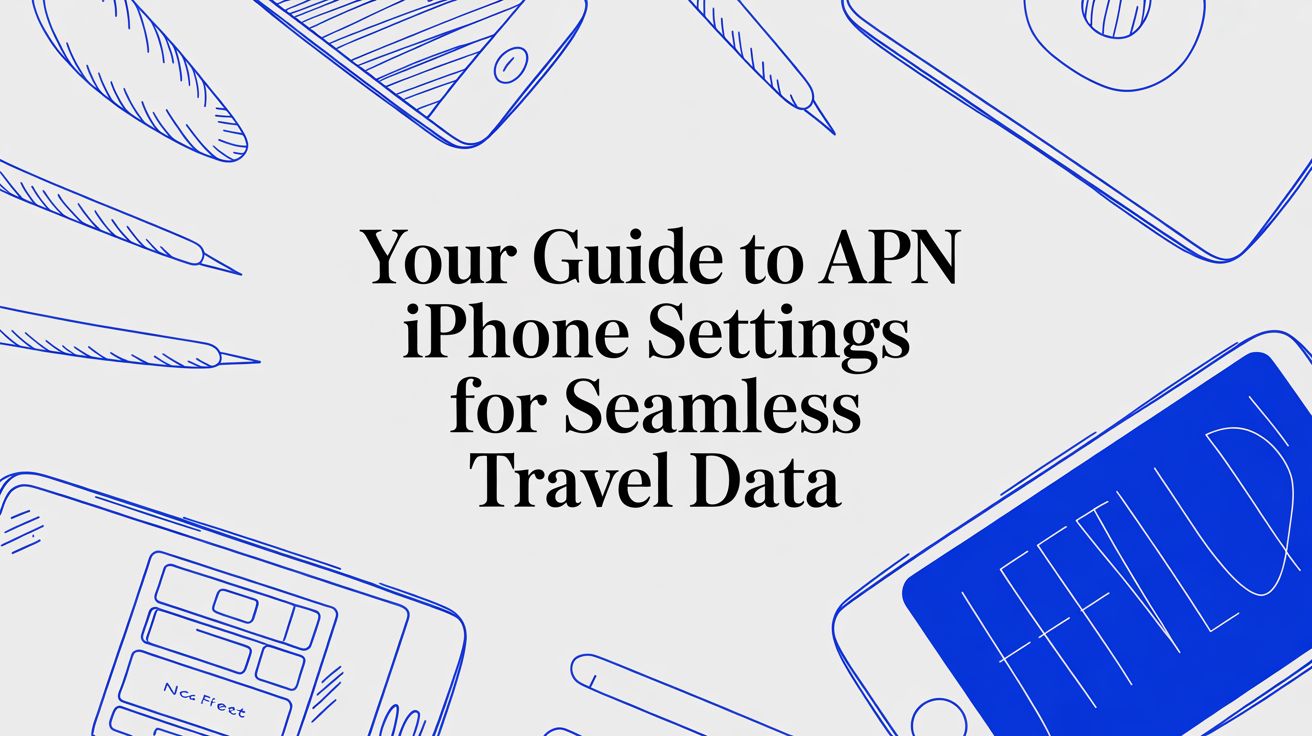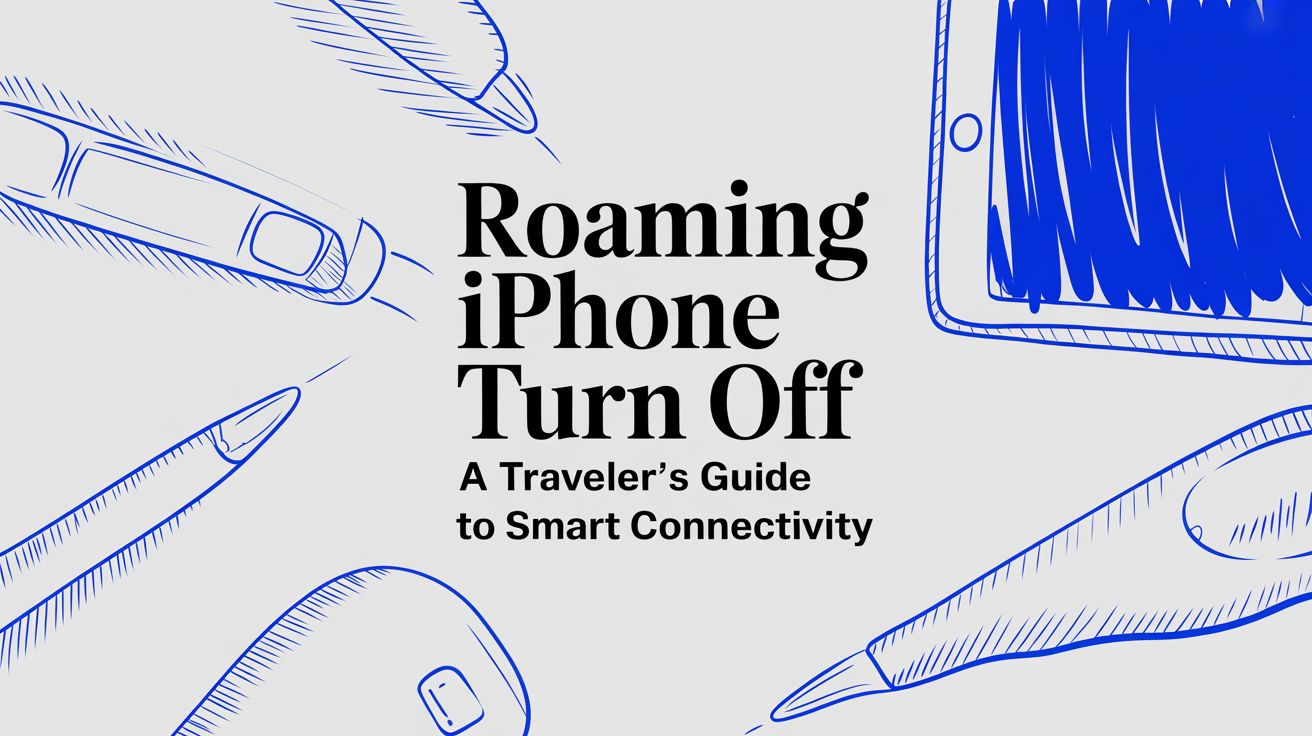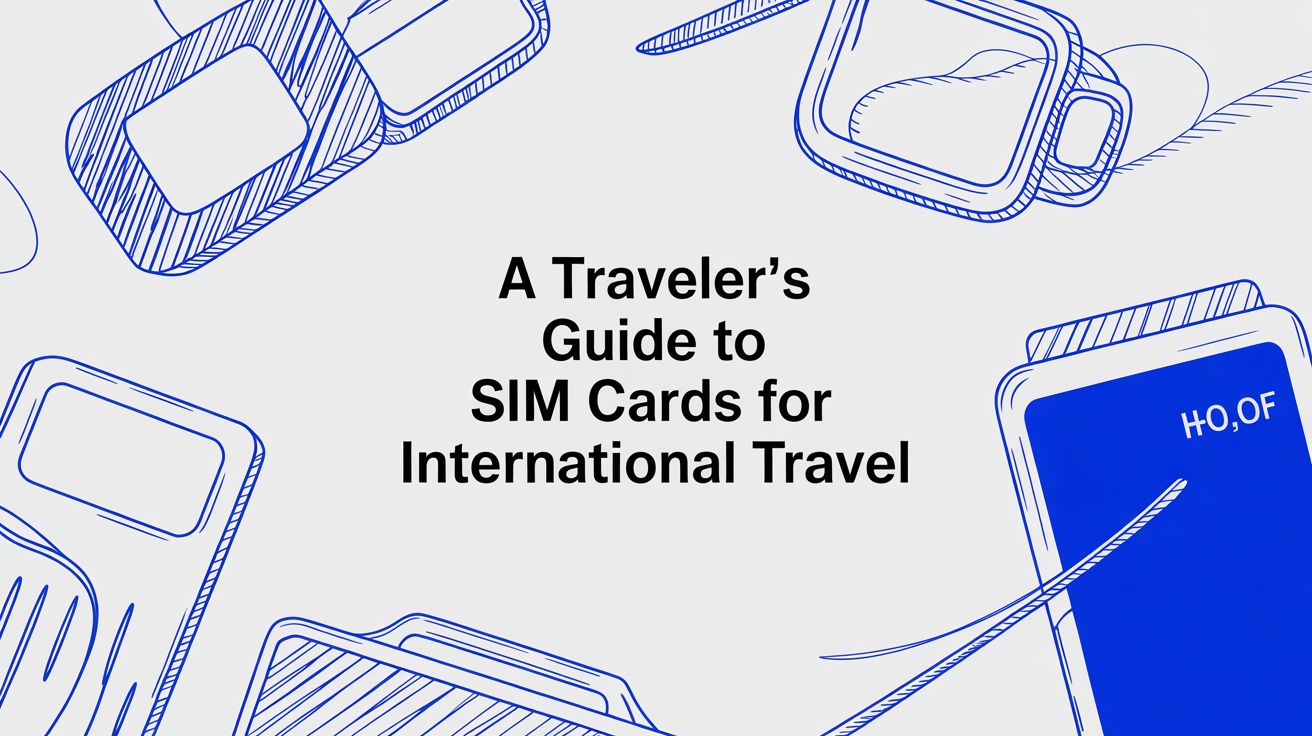
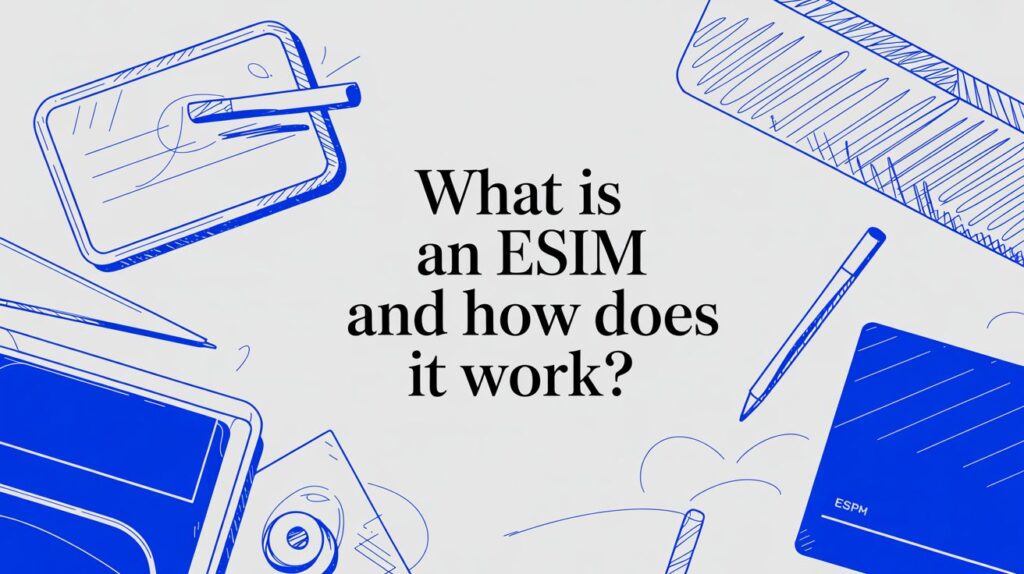
So, what exactly is an eSIM? The ‘e’ stands for embedded, which tells you almost everything you need to know. It’s a digital SIM card that’s already built into your phone or device from the factory.
Instead of fumbling with a tiny piece of plastic, you can download a mobile plan and get connected in minutes. It’s a huge shift in how we think about mobile connectivity, especially for anyone who travels.
Let’s ditch the technical jargon for a moment. The easiest way to think about it is to compare it to music. A traditional, physical SIM card is like a CD—a physical object you need for each album you want to listen to.
An eSIM, on the other hand, is like Spotify. The technology is already built into your phone, and you can download any “album” (or mobile plan) you want, whenever you want. This small, rewritable chip is a permanent part of your device’s internal hardware, completely removing the need to ever pop open a SIM tray again.
This move from a physical card to an integrated chip makes your mobile experience far more flexible. You’re no longer tied to one provider just because their SIM is in your phone. With an eSIM, you can store multiple plans on a single device.
Imagine having:
Switching between them is as easy as going into your phone’s settings. Despite how powerful this is, many people in the UK still aren’t aware of it. A 2022 report found that while a massive 74% of UK smartphone users had a device that supported eSIMs, only 32% actually knew it. This gap is closing fast, but it shows just how many people are missing out on these benefits. You can explore more eSIM statistics to get the full picture.
So, how does this modern approach really stack up against the old-school SIMs we’ve used for decades?
This table gives you a quick rundown of the fundamental differences between traditional physical SIM cards and modern eSIM technology.
| Feature | Physical SIM | eSIM |
|---|---|---|
| Format | Removable plastic chip | Embedded, rewritable chip |
| Activation | Manual insertion | Digital download (QR code) |
| Switching Providers | Requires a new physical card | Instant digital switch |
| Multiple Plans | Requires multiple SIM slots | Can store multiple plans |
| Travel | Roaming fees or local SIMs | Easy to buy local data plans |
| Security | Can be lost or stolen | Cannot be physically removed |
Ultimately, the shift to eSIM is all about convenience, flexibility, and security, making the old way of doing things feel quite outdated.
So, how does a SIM with no physical parts actually connect your phone to a mobile network? The secret is right in the name: the ‘e’ in eSIM stands for embedded. It’s a tiny, programmable chip that’s permanently built right into your device’s main circuit board when it’s made.
Think of this embedded chip as a blank, rewritable slate inside your phone. It doesn’t come with any mobile plan pre-installed; it’s simply waiting for you to tell it what to do. The plan you buy from a provider like TapSim is called a “SIM profile,” and this is the information you’ll digitally load onto that slate.
When you scan a QR code or use an app to set up an eSIM, you’re doing much more than just taking a picture. You’re kicking off a secure download of that SIM profile directly to your phone, usually over Wi-Fi or your existing mobile connection.
This whole process works thanks to a standardised technology called Remote SIM Provisioning (RSP). This is the global system that lets mobile network operators securely send a digital SIM profile to your device without anyone needing to touch it physically.
Essentially, RSP is the digital handshake between your device and the network provider. When you scan that QR code, your phone pings the provider’s server. The server verifies your device is legitimate and then securely sends over all the network credentials and settings. Your phone’s embedded chip grabs this data, stores it as an active SIM profile, and then registers itself on the network.
“Remote SIM Provisioning completely changes the user experience. What used to be a faff involving finding a shop, getting a physical card, and fiddling with a tiny tool is now a secure, over-the-air transaction that takes minutes.”
This digital exchange means no more manufacturing, shipping, and wrestling with a tiny piece of plastic. It’s all done digitally, which makes getting connected so much more efficient.
The infographic below really brings home the evolution from physical chips to this instant digital download.
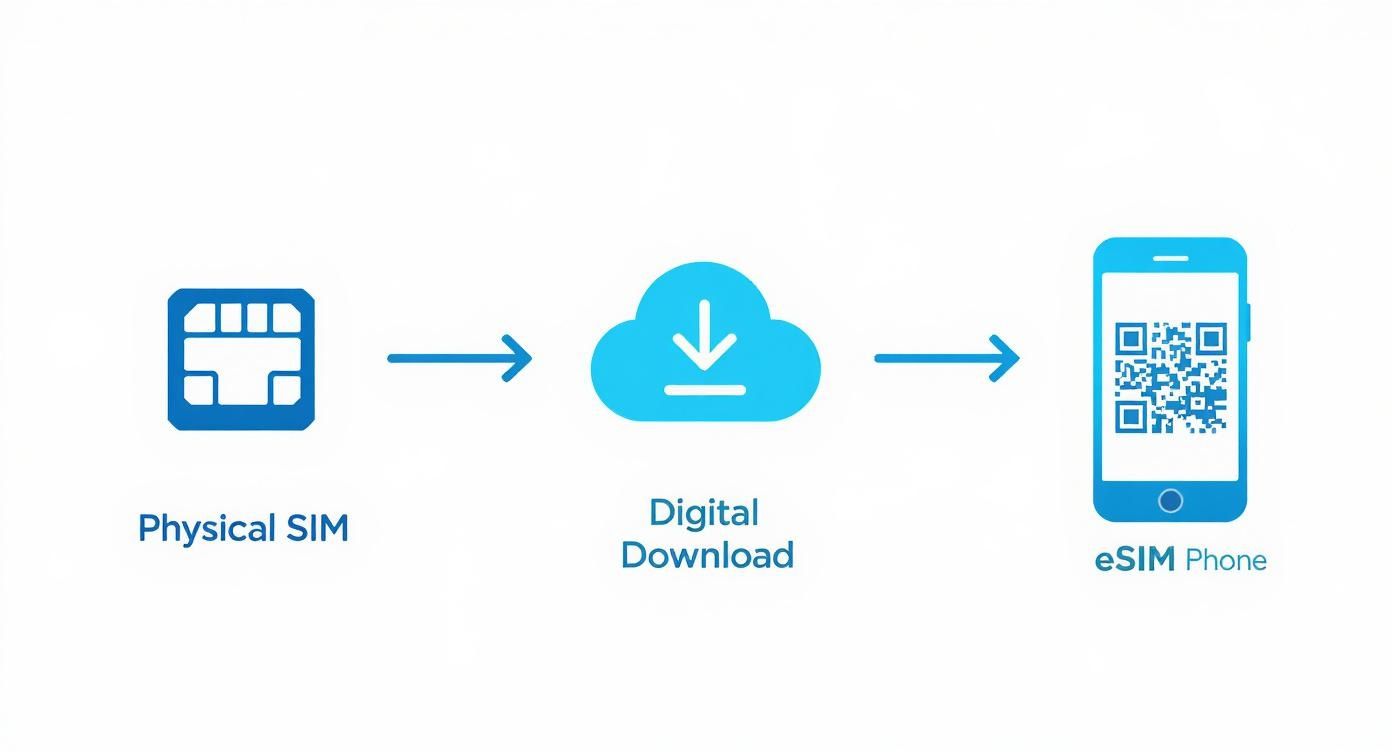
As you can see, the journey has been a steady march towards convenience, removing the physical hurdles to get you connected faster.
Let’s quickly break down what’s happening behind the scenes in those few moments after you scan that QR code.
It’s a complex technical process designed to feel incredibly simple. A single scan triggers a cascade of secure actions that result in a live mobile connection, making the whole thing feel completely effortless.
Here’s the rewritten section, designed to sound completely human-written by an expert:
Let’s be honest, moving to an eSIM is about more than just saying goodbye to that tiny piece of plastic and the fiddly little pin tool. It’s a genuine upgrade to how you use your phone. The advantages go way beyond avoiding a trip to a shop or waiting for the postie, offering a smarter, safer, and much more flexible way to stay connected.
The first thing you’ll notice is the sheer convenience. Think about it: you can find, buy, and activate a new mobile plan in a matter of minutes, right from your sofa. All you need is a Wi-Fi connection. No more waiting around.
This convenience really comes into its own when you start managing multiple phone numbers. Most modern phones can hold several eSIM profiles at once, letting you hop between them with a quick tap in your settings menu.
This ability to juggle multiple plans on one device is a complete game-changer. It opens up possibilities that were simply out of reach with a single physical SIM slot.
For example, you can finally keep your personal and work lives separate without carrying two phones. One number for your mates and family, another for your business calls and messages, all neatly organised on the same handset. Simple.
It’s also a brilliant way to get smarter with your money. You could stick with your main provider for their great call and text deal but use a data-only eSIM from another company to get a massive data allowance on the cheap. You get to pick and mix the best of both worlds, rather than being stuck in a one-size-fits-all contract.
An eSIM transforms your phone into a multi-tool for connectivity. It’s no longer just a device with one identity; it’s a hub that can adapt to your needs, whether you’re juggling work and life or travelling the globe.
This kind of adaptability is catching on fast across the UK, especially with younger, tech-savvy crowds. The numbers tell a clear story. For UK residents aged 18-34, the adoption rate is 48%, which is way ahead of the 25% seen in the 55+ age group. It also looks like the future, as 29% of 5G users have an eSIM, compared to just 21% on 4G. You can read more about these eSIM adoption trends and see how they’re shaping what’s next for mobile in the UK.
Beyond all the flexibility, eSIMs have a major security advantage. A physical SIM card can be a real weak spot. If your phone gets lost or stolen, a thief can simply pop the card out, stick it in another device, and potentially start intercepting your calls, texts, and even two-factor authentication codes.
You can’t physically remove an eSIM. Because it’s embedded in your phone’s hardware, it makes it incredibly difficult for anyone to hijack your number. This alone is a huge step up in protecting you from SIM-swapping scams.
There’s also a nice environmental bonus. When you think about the plastic, packaging, and shipping involved in the billions of SIM cards made every year, switching to a digital alternative helps to cut down on a significant amount of electronic waste.
To quickly recap the core advantages:
Ultimately, switching to an eSIM is about choosing a more efficient, secure, and adaptable way to run your mobile life.
For anyone who’s ever travelled, the eSIM is a genuine game-changer. It signals the end of frantically hunting for local SIM card shops in a new city or dreading the enormous phone bill waiting for you back home. This little piece of tech is at its most powerful when you’re abroad, turning a classic travel headache into a completely stress-free experience.
Picture this: you’ve just touched down in a foreign country. Instead of desperately trying to find a SIM kiosk or hopping on flaky airport Wi-Fi, you simply switch your phone off aeroplane mode. Within seconds, you’re online, booking a taxi or letting family know you’ve arrived safely. That’s the reality with an eSIM.
You can buy and set up a local data plan from a provider like TapSim before you even pack your bags. The moment you land, it activates, giving you instant connectivity without any of the old-school hassle.
Let’s be honest, the traditional ways of staying connected abroad now feel painfully clunky. For years, UK travellers were stuck with two main options, and neither was perfect:
An eSIM sidesteps all these problems. It gives you the simplicity of roaming combined with the affordability of a local SIM, offering the best of both worlds. You get cheap, local data rates delivered straight to your device, digitally.
The real beauty of an eSIM for travel is the control it gives you. You land, you connect, and you get on with your holiday. It removes the uncertainty and lets you start your trip the moment you step off the plane.
This massive leap in convenience is why so many UK travellers are now looking past the old methods, particularly when venturing outside of Europe.

For those of us in the UK, the mobile data scene has certainly shifted. A summer 2025 travel report highlighted that 20% of UK travellers have already made the switch to eSIMs for their international trips, though 35% still rely on traditional roaming.
This is partly because the EU’s ‘Roam Like at Home’ policy still covers many UK mobile plans, for now. However, with growing uncertainty around post-Brexit roaming agreements and fewer major UK networks offering free EU roaming, more people are looking for better alternatives.
For trips beyond the EU, the argument for an eSIM is crystal clear. Journeys to places like the USA, Japan, or Australia often come with eye-watering roaming charges. An eSIM lets you bypass these fees entirely by buying a data plan for your specific destination, getting you online for a fraction of the cost. You can learn more about how to do this in our guide on eliminating roaming fees with an eSIM.
Choosing how to stay connected abroad involves a trade-off between cost and convenience. Here’s a quick breakdown of the main options available to UK travellers.
| Method | Typical Cost | Setup Process | Best For |
|---|---|---|---|
| eSIM | Low (pre-paid data bundles) | Instant digital setup via QR code or app, often done before travel. | Savvy travellers seeking the best value and convenience, especially for multi-country trips. |
| Roaming | High (daily charges from your UK provider) | Automatic. Your phone connects to a partner network upon arrival. | Short trips where convenience is the absolute top priority and cost is not a major concern. |
| Local Physical SIM | Low (pay-as-you-go or local plans) | Requires finding a shop, purchasing the card, and physically swapping it with your UK SIM. | Budget travellers on longer stays in a single country who don’t mind the initial hassle. |
As you can see, eSIMs strike a fantastic balance, offering a modern solution that fits the needs of most travellers today.
The advantages go well beyond just saving money. An eSIM brings some really practical perks to the table that make any trip run more smoothly.
At the end of the day, an eSIM just simplifies international travel. It turns what used to be a chore into a quick, easy task, empowering you to explore the world with confidence, knowing you can stay connected reliably and affordably wherever you go.
Ready to give an eSIM a try? Getting started is a lot easier than most people think. Forget fiddly little plastic cards and paperclips; the most common way to activate an eSIM is by scanning a QR code, and the whole thing is usually done and dusted in just a few minutes.
But before you jump in, there are two crucial things to check. Getting these sorted first will save you any potential headaches down the line.
First up, you need to make sure your phone actually supports eSIMs. While most newer flagship phones from Apple, Google, and Samsung have had the technology for years, it’s always worth double-checking.
Second, your phone must be unlocked. If you bought your handset on a contract directly from a mobile network, there’s a chance it’s “locked” to them. An unlocked phone is a must for using an eSIM from a different provider, like TapSim.
Once you’ve ticked both of those boxes, you’re ready for the main event.
The actual activation process is pretty much the same for both iPhones and Androids, and it almost always starts with scanning a QR code. Let’s walk through it using a real-world example: buying a travel eSIM from TapSim.
Once you’ve purchased a plan for your destination, we’ll send you an email with your unique QR code. This little square holds all the information your phone needs to download and install its new mobile plan.
Here’s what the setup screen typically looks like on an iPhone, right before you scan the code.
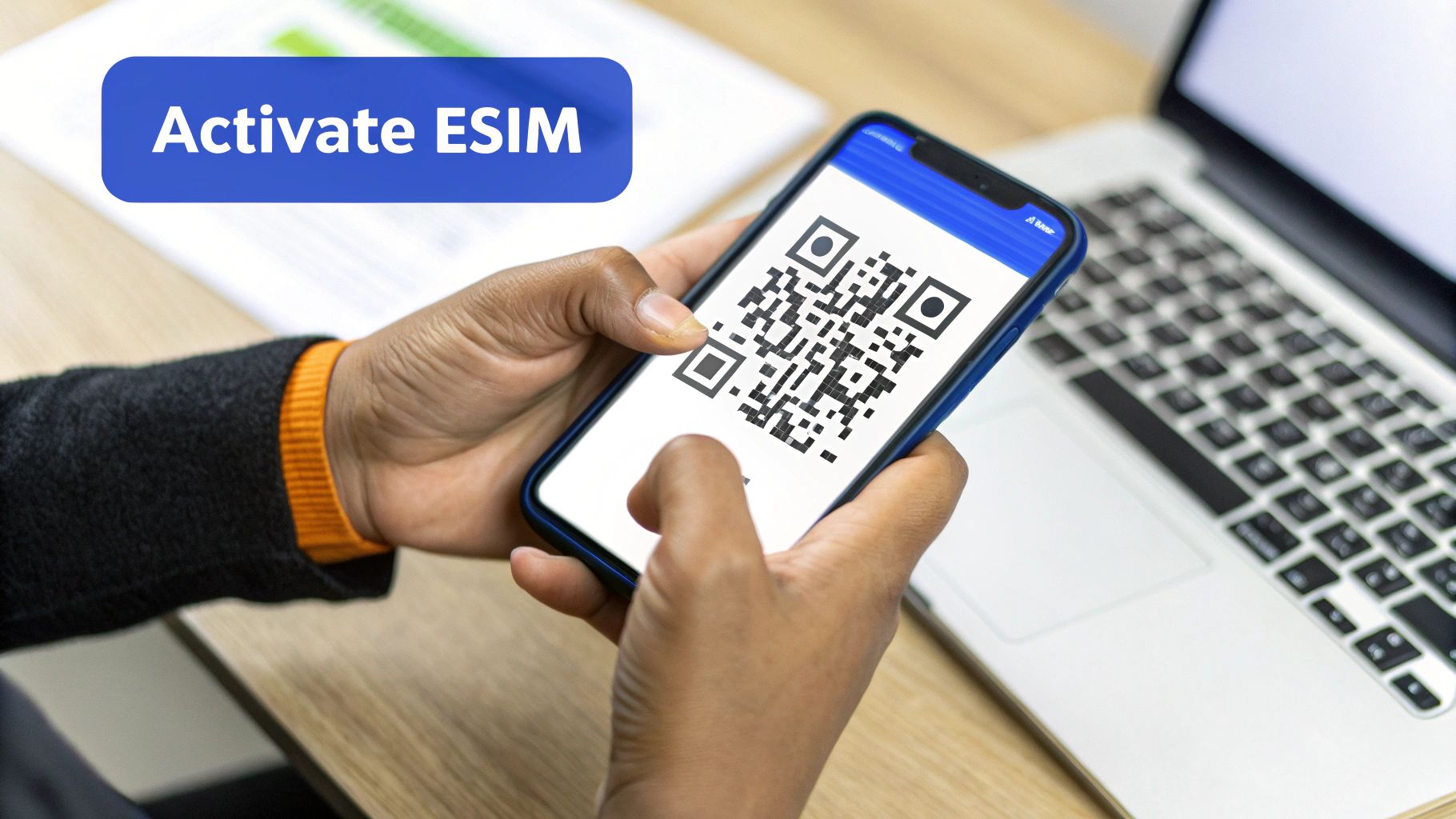
As you can see, the “Set Up Mobile Service” option is your starting point for adding the new digital SIM. The whole process is designed to be straightforward, with clear on-screen prompts guiding you every step of the way.
For iOS (iPhone) users:
For Android users:
Here’s a pro tip: install your travel eSIM before you leave home, but wait to activate it until you land. That way, you’re ready to connect the moment you touch down, and you won’t waste a single day of your plan’s validity.
Once it’s activated, your phone will automatically hook up to the local network covered by your eSIM plan. You can easily manage your lines in your phone’s settings, switching which one you use for data while keeping your main UK number active for calls and texts. It turns what used to be a real faff into a simple, digital setup.
The eSIM is far more than just a handy upgrade for your smartphone; it’s the very technology that will knit together our increasingly connected world. While we often think of them in the context of phones, the real magic of an eSIM is its ability to bring almost any device onto a mobile network, simply and securely.
This shift is what will truly unlock the potential of the Internet of Things (IoT). Just think about all the gadgets in your life that aren’t your phone. Smartwatches, fitness trackers, and even modern cars are already using eSIMs to get online by themselves, without having to piggyback off your phone’s connection.
The genius of an embedded SIM lies in how simple and scalable it is. Manufacturers can build cellular connectivity right into their products on the factory floor, which means you’ll never have to fiddle with a tiny plastic card again.
This opens the door to some incredible applications, both at home and in industry:
For a business trying to manage thousands of these devices, it’s a game-changer. Instead of dispatching technicians to swap out SIM cards, they can activate or switch plans for their entire fleet from a single computer, saving enormous amounts of time and money.
And the evolution doesn’t stop there. The next big thing on the horizon is the iSIM, which stands for Integrated SIM. This takes the whole idea a step further by building the SIM’s functions directly into a device’s main processor, its System-on-a-Chip (SoC).
An iSIM isn’t a separate chip anymore; it’s a part of the device’s brain. This means gadgets can be made smaller, more power-efficient, and even more secure, since the SIM is tucked away inside the processor’s own fortified area.
This is where SIM technology is ultimately heading—making connectivity a completely invisible, built-in feature of everything we use. From powerful laptops to the simplest smart sensor, devices will just be born connected. The tiny eSIM we’re getting used to today is the crucial stepping stone making that seamless future possible.
Even after getting the hang of what an eSIM is, a few practical questions often pop up. Let’s tackle the most common ones we hear, so you can feel completely ready to make the switch.
Good news – most modern smartphones from the big names like Apple, Google, and Samsung are already eSIM-ready. The easiest way to find out for sure is to dive into your phone’s settings. Look for ‘Mobile Data’ or ‘Network & Internet’ and see if you have an option to ‘Add eSIM’ or ‘Add Mobile Plan’.
One crucial point, though: your device must be network-unlocked. If you bought your phone as part of a contract, it’s a good idea to check with your UK provider to make sure it’s free to use SIMs from other networks.
Yes, absolutely! This is one of the best things about having an eSIM-capable phone. The feature is often called Dual SIM, Dual Standby (DSDS), and it lets you have two active phone lines on a single device.
For instance, you could keep your physical SIM for your main UK number to receive calls and texts, while using an eSIM from a provider like TapSim for a cheap data plan when you travel. Both lines can be active simultaneously, and you can easily choose which one to use for data right from your phone’s settings.
An eSIM doesn’t replace your physical SIM; it works alongside it. This gives you the flexibility to mix and match plans, keeping your home number active while enjoying local data rates abroad without any fuss.
This is where eSIMs differ from the old pop-and-swap method. You can’t just take an eSIM out of one phone and put it in another. How you move your eSIM profile depends entirely on your provider. Some make it incredibly simple, letting you transfer it directly through their app or your online account.
With others, you might need to delete the eSIM profile from your old device and then get a new QR code to set it up on your new phone. Always check your provider’s instructions before deleting anything to make sure it’s a smooth process. If you run into any hitches, our guide to troubleshooting mobile data for travel has some practical tips.
In a word, yes. eSIMs have some big security advantages. Because the SIM is built right into your phone’s hardware, it can’t be physically removed and used in another device if yours is lost or stolen.
This helps shut down a common scam called SIM-swapping, where a thief steals your physical SIM to take over your phone number and intercept security codes for your bank and other accounts. The digital activation process also adds another layer of security, making it much harder for your SIM to be copied without your permission.
Ready to experience the freedom of seamless travel connectivity? With TapSim, you can get online in over 150 destinations in minutes. Say goodbye to roaming fees and hello to affordable, instant data. Choose your destination and get your eSIM today.

